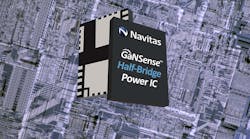This article is part of the TechXchange: Power Supply Design.
Navitas Semiconductor rolled out its new family of fully integrated half-bridge gallium-nitride (GaN) ICs, seeking to further shake up the silicon-dominated market for power electronics.
The power semiconductor maker said the new chips reduce component count and the area of a complete half-bridge on a circuit board by more than 60%. Navitas further said that the result is better overall performance, reliability, and power density, while keeping system cost and complexity in check.
According to the company, the new series of GaN-based half-bridge power ICs promises to usher in a wide range of new power-converter applications and upgrade them from kilohertz to megahertz switching frequencies.
Power Boost
GaN offers a host of unique physical properties that make it ideal for power-conversion devices, such as reduced parasitic capacitances for a given on-resistance (RDS(on)) and inherently fast switching transients.
The lack of reverse recovery and the ability to tolerate elevated temperatures and safely handle high voltages are also part of the power of GaN. Zooming out to the system level, you can use GaN to pack more power into everything from fast chargers to solar inverters to power converters in electric cars. It supports smaller form factors that weigh less and generate less heat, improving power density and offering major efficiency gains.
The high switching frequencies of GaN shrink the size, weight, and cost of the transformers, capacitors, EMI filters, and other passive components that round out a typical power system, said Navitas.
There are tradeoffs, though. Due to its uniquely fast switching frequencies and other advanced power-handling capabilities, it can be challenging to drive and control GaN-based power FETs. As a result, GaN FETs must frequently be paired with a special-purpose driver IC to wring out the best possible performance.
Navitas addressed that issue by integrating the gate driver with the power stage monolithically to switch faster and better drive and control the power ICs from damage—a feature shared by the new half-bridge switches.
The new chips also contain a wide range of built-in defenses: autonomous overcurrent protection (OCP), overtemperature protection (OTP), plus shoot-through protection and the ability to tolerate electrostatic discharge (ESD) of up to 2 kV.
Half-Bridge-in-a-Package
However, in practice, power-electronics systems rarely rely on a single switch.
Specifically, the half-bridge, one of the most universal configurations in power electronics and widely used in motor drivers and inverters, uses a pair of power switches and a grouping of additional passives and devices.
Modern variable-speed drives for electric motors, found in everything from HVAC systems to industrial robotics and electric vehicles, use three half-bridges to create a “three-phase” inverter topology, said Navitas.
The onboard charger (OBC) in a modern electric vehicle also uses several half-bridges to handle both the input power-factor-correction (PFC) stage of the system as well as the isolation plus dc-dc converter stage.
At higher power levels, ac-dc power supplies in data centers contain several half-bridge building blocks. In many cases, depending on the topology of the power stage, the half-bridges have to run at different frequencies.
Navitas’ new series of half-bridge power ICs include a pair of GaN FETs with drive and autonomous control features to create this fundamental power-stage building block. Another feature is the “lossless” current sensing, which wrings out higher efficiencies and power savings. Level-shift isolation and high-side bootstrapping are in there, too.
Integrating more of the half-bridge in a single package also keeps parasitics and other characteristics that can hurt the device’s performance in check, said Navitas. That translates to faster and cleaner switching speeds.
Looking Ahead
The new GaN half-bridge ICs fit into LLC resonant, asymmetric half-bridge (AHB), active-clamp flyback (ACF), and other ac-dc power converters. They are also ideal for the increasingly popular totem-pole PFC topology.
Fast chargers for smartphones and other consumer devices continue to hit higher power levels. The new USB PD 3.1 protocol supports delivery of up to 240 W of power using USB Type-C cables and connectors. When it comes to these higher power levels, as Navitas sees it, soft-switching half-bridge power-converter topologies powered by GaN bring the fastest switching frequency and best power density to the table.
Navitas said the new IC series is well-suited for soft-switching, which helps eliminate excess voltage and/or current across the power device before it is switched “on” or “off,” limiting capacitive- and switching-related losses.
Gene Sheridan, CEO of Navitas, said the first generation of its “GaNFast” family increased frequencies from 50-60 kHz to 200-500 kHz. He added: “the GaNSense half-bridges elevate those benefits into the MHz range.”
The first power ICs in the half-bridge GaN family includes the NV6247, rated at 650 V, 160 mΩ (dual), and NV6245C, rated at 275 mΩ (dual). They are housed in standard low-inductance, 6- × 8-mm PQFN packages.
Navitas said the NV6247 is targeted at consumer electronics, including mobile fast chargers, with power levels ranging from 100 to 140 W, and home appliances such as fans with power of up to 400 W.
The company, which has shipped more than 50 million GaN ICs to date and introduced a 20-year warranty for its GaN-based ICs this year, plans to expand the GanSense Half-Bridge family in the future.
Navitas revealed that a host of new packages and power levels will be available in the coming quarters.
This article is part of the TechXchange: Power Supply Design.
